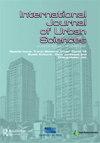Socio-spatial differentiation in a Latin American metropolis: urban structure, residential mobility, and real estate in the high-income cone of Santiago de Chile
IF 3
3区 工程技术
Q2 ENVIRONMENTAL STUDIES
引用次数: 1
Abstract
ABSTRACT The High-Income Cone (HIC) is characteristic of the urban structure of Latin-American metropolises, consisting of a delimited area of the city where inhabitants of high socioeconomic status are located, consolidating the patterns of social segregation and inequality that are typical of those societies. Despite the urban transformations experienced by the metropolises of the continent in the last decades, little study has been done to understand the internal dynamics of HICs, which are usually considered a socially homogeneous space. This article delves into the internal complexities of the HIC of Greater Santiago, investigating its residential mobility processes and distinguishing between traditional and recent inhabitants, or ‘inheritors’ and ‘achievers’. Our results indicate the presence of parallel processes of residential mobility, where ‘achievers’ are concentrated in the apartments located in the pericentral zone of the HIC, while ‘inheritors’ move to the houses located in the extreme east. This process of permeability and filtering is conditioned by the recent trends of neoliberal urban densification and expansion, where the construction of more accessible buildings allows the arrival of certain people to the pericentral areas of the HIC, while the more exclusive houses and gated-communities far east are more accessible for inheritors.拉丁美洲大都市的社会空间分化:智利圣地亚哥高收入区的城市结构、住宅流动性和房地产
摘要:高收入锥(HIC)是拉丁美洲大都市的城市结构特征,由社会经济地位较高的居民所在的城市边界区域组成,巩固了这些社会典型的社会隔离和不平等模式。尽管欧洲大陆的大都市在过去几十年中经历了城市转型,但很少有研究来了解HIC的内部动态,HIC通常被认为是一个社会同质的空间。本文深入探讨了大圣地亚哥HIC的内部复杂性,调查了其住宅流动过程,并区分了传统居民和现代居民,或“继承者”和“成就者”。我们的研究结果表明,住宅流动存在平行过程,其中“成就者”集中在HIC中心附近的公寓,而“继承者”则转移到位于最东部的房子。这种渗透和过滤过程受到新自由主义城市密集化和扩张的最新趋势的制约,在这种趋势下,建造更容易进入的建筑可以让某些人到达HIC的中心附近地区,而更排外的房屋和大门社区对继承人来说更容易进入。
本文章由计算机程序翻译,如有差异,请以英文原文为准。
求助全文
约1分钟内获得全文
求助全文

 求助内容:
求助内容: 应助结果提醒方式:
应助结果提醒方式:


